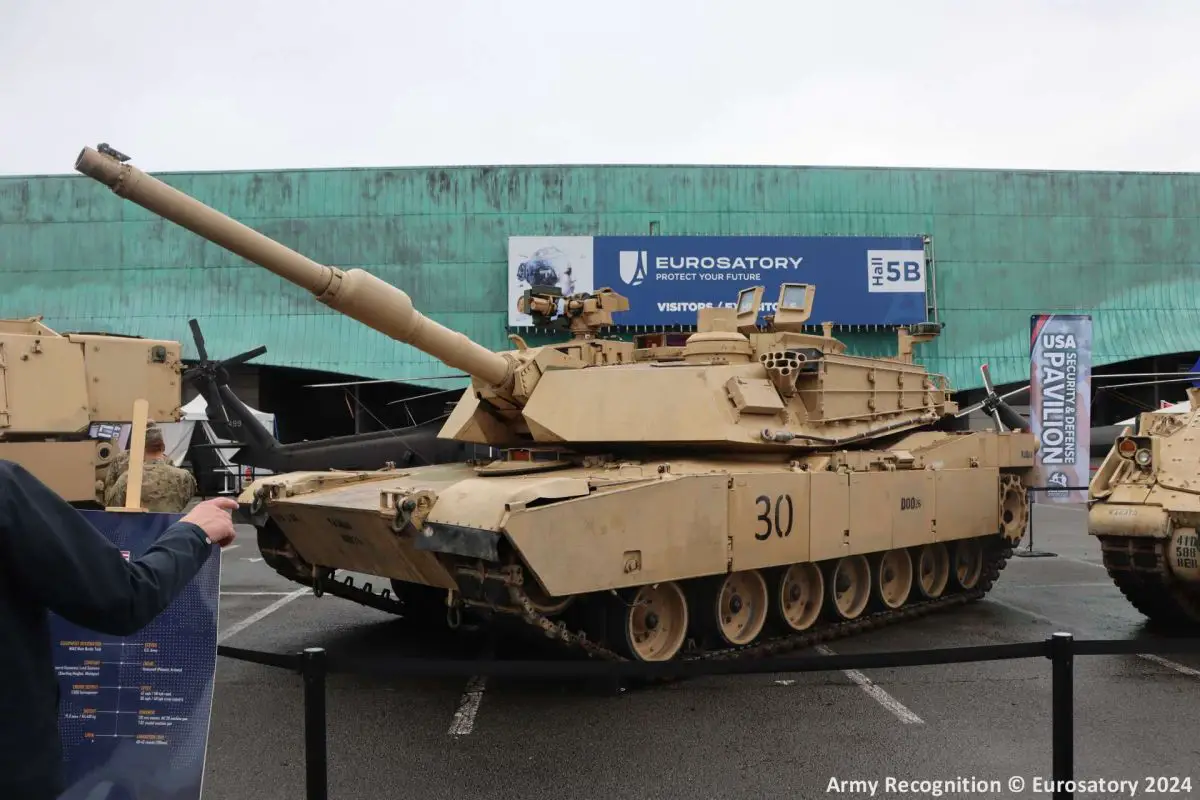Breaking News
US Army displays M1A2 Abrams Main Battle Tank and more at Eurosatory 2024.
At Eurosatory 2024, the US Army is showcasing a range of its armored vehicles, including the M1A2 Abrams Main Battle Tank, the M2A3 Bradley Infantry Fighting Vehicle, and the M109 Paladin self-propelled howitzer. The M1A2 Abrams, a third-generation main battle tank, is known for its firepower, capable of engaging enemy tanks and fortified positions at ranges up to 4,000 meters.
Follow Army Recognition on Google News at this link

The primary armament of the M1A2 Abrams is a 120mm M256 smoothbore cannon that fires a variety of ammunition types, including armor-piercing fin-stabilized discarding sabot (APFSDS) rounds and high-explosive anti-tank (HEAT) rounds. (Picture source: Army Recognition)
The M1 Abrams has several variants, with the primary combat models being the M1, M1A1, and M1A2. The M1A1 introduced a 120mm gun and improved armor, while the M1A2 added advanced electronics and a commander's independent thermal viewer. The M1A2 SEP (System Enhancement Package) models include upgrades such as improved armor, electronics, and the addition of an auxiliary power unit. Other variants include the M1A2 SEPv3 and the M1A2K for the Kuwaiti Army.
The M1A2 Abrams, named after General Creighton Abrams, is a variant of the M1 Abrams main battle tank. The M1 Abrams series, developed by Chrysler Defense (now General Dynamics Land Systems), began replacing the M60 tank in 1980. The M1A2, approved for production in 1990, includes numerous technological advancements over its predecessors. These tanks were first used in combat during the Gulf War and have been involved in subsequent conflicts such as the Iraq War and the War in Afghanistan.
The primary armament of the M1A2 Abrams is a 120mm M256 smoothbore cannon that fires a variety of ammunition types, including armor-piercing fin-stabilized discarding sabot (APFSDS) rounds and high-explosive anti-tank (HEAT) rounds. These munitions enable effective engagement of enemy tanks and fortified positions at ranges up to 4,000 meters. Secondary armaments include a .50 caliber M2 heavy machine gun and two 7.62mm M240 machine guns.
The M1A2 Abrams has demonstrated high effectiveness and survivability in combat situations. During Operation Desert Storm, Abrams tanks achieved a high kill ratio against Iraqi armor with minimal losses. The advanced fire control system, which includes a laser rangefinder and ballistics computer, plays a crucial role in this effectiveness. The tank's composite armor, enhanced with depleted uranium layers in later models, offers significant protection against kinetic and chemical energy threats.
The M1A2 Abrams weighs approximately 62 metric tons and is powered by a Honeywell AGT1500 gas turbine engine, producing 1,500 horsepower (1,120 kW). It can reach speeds up to 67 km/h on roads and 40 km/h off-road. The operational range is around 426 km on roads and 150 to 200 km cross-country. The crew consists of four members: commander, gunner, loader, and driver. Features include a sophisticated fire control system, advanced thermal imaging, and an NBC (nuclear, biological, chemical) protection system.
The M1A2 Abrams is used by the United States Army and has been exported to several allied nations, including Australia, Egypt, Iraq, Kuwait, Poland, and Saudi Arabia. Each country customizes its Abrams tanks to meet specific operational needs, ensuring the platform continues to serve effectively in diverse combat environments worldwide.


























